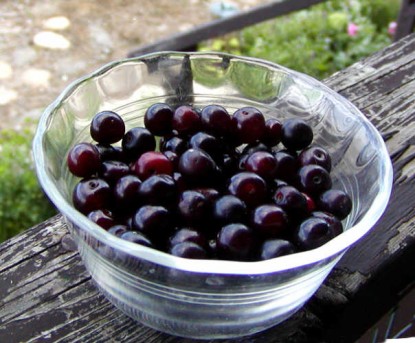
This year I began to forage over our property and the adjoining county forest. I am amazed at what I found growing here! We have been blessed with so much that we can use, right here at home, overlooked by most of society!
The medicinal herbs that grow here are astounding and are just growing wild in the fields! No one uses them, no one harvests them, many don’t even realize what they are or how useful and effective they can be. I was one of these people until recently.
Now I look at everything with new eyes. I research every plant I find growing here if I have the time. The medicinal uses of goldenrod alone have been a bit of a shock. We are over run with it and I truly thought it useless, until recently. Now I have armloads of it hanging to dry for winter tea.
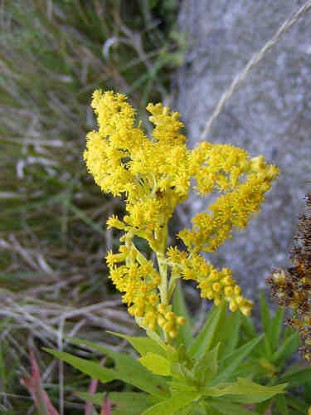
There are fruits growing wild here that I have used and will use to make wine, such as the wild grapes, wild red and black raspberries, wild blackberries, choke cherries, and more.
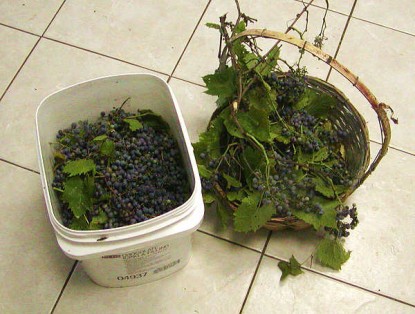
There is a large colony of mushrooms here, shaggy manes, that are ranked very high on the list by professional cooks for their flavour. I am expecting these to make their yearly appearance any time now. I have the grass and weeds cut down to the ground in the area where they grow. I intend to cook and freeze them this year. I am also going to attempt to spread them to other areas, more accessible, on the property. They like disturbed ground and I have just the spot waiting for them.
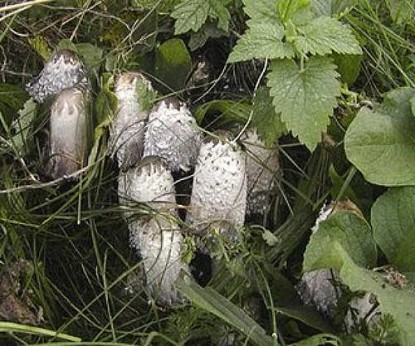
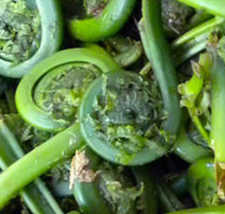 Also, I believe I have found a few large colonies of ostrich ferns nearby! I know they are not cinnamon ferns, which also grow here. I will do some research to make sure, but if they are truly ostrich ferns, we will have plenty of fiddleheads in the spring!
Also, I believe I have found a few large colonies of ostrich ferns nearby! I know they are not cinnamon ferns, which also grow here. I will do some research to make sure, but if they are truly ostrich ferns, we will have plenty of fiddleheads in the spring!
There are cattails growing in the ditch and I know that their roots are very good baked, as a starch, although I think we will skip that one in favour of potatoes and rice or pasta, for now. They will still be there, if we should ever need them.
Foraging has become and important part of my family food resource. One of my favourite sites for foraging information is Forager’s Harvest.
Below is an excerpt from their post on milkweed. I had no idea that milkweed was even edible! I am going to try them next spring, especially using the silks like cheese!
“Milkweed season begins in late spring, just about the time that leaves are coming out on the oak trees, when the shoots come up near the dead stalks of last year’s plants. These resemble asparagus spears but have tiny leaves, in opposing pairs, pressed up flat against the stem. Until they are about eight inches tall, milkweed shoots make a delicious boiled vegetable. Their texture and flavor suggests a cross between green beans and asparagus, but it is distinct from either. As the plant grows taller, the bottom of the shoot becomes tough. Until it attains a height of about two feet, however, you can break off the top few inches (remove any large leaves) and use this portion like the shoot.
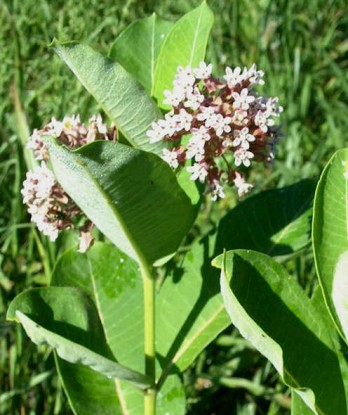
Milkweed flower buds first appear in early summer and can be harvested for about seven weeks. They look like miniature heads of broccoli but have roughly the same flavor as the shoots. These flower buds are wonderful in stir-fry, soup, rice, casseroles, and many other dishes. Just make sure to wash the bugs out.
In late summer milkweed plants produce the familiar pointed, okra-like seedpods which are popular in dried flower arrangements. These range from three to five inches long when mature – but for eating you want the immature pods. Select those that are no more than two thirds of their full size. It takes a little experience to learn the knack of how to tell if the pods are still immature, so as a beginner you might want to stick to using pods less than 1 ¾ inches in length to be safe. If the pods are immature the silk and seeds inside will be soft and white without any hint of browning. It is good to occasionally use this test to verify that you are only choosing immature pods. If the pods are mature they will be tough and bitter. Milkweed pods are delicious in stew or just served as a boiled vegetable, perhaps with cheese or mixed with other veggies.
Silk refers to the immature milkweed floss, before it has become fibrous and cottony. This is perhaps the most unique food product that comes from the milkweed plant. When you consume the pod, you are eating the silk with it. At our house, we eat the smallest pods whole, but we pull the silk out of the larger (but still immature) pods. Open up the pod along the faint line that runs down the side, and the silk wad will pop out easily. If you pinch the silk hard, your thumbnail should go right through it, and you should be able to pull the wad of silk in half. The silk should be juicy; any toughness or dryness is an indicator that the pod is over mature. With time, you will be able to tell at a glance which pods are mature and which are not.
Milkweed silk is both delicious and amazing. It is slightly sweet with no overpowering flavor of any kind. Boil a large handful of these silk wads with a pot of rice or cous cous and the finished product will look like it contains melted mozzarella. The silk holds everything together, so it’s great in casseroles as well. It looks and acts so much like cheese, and tastes similar enough too, that people assume that it is cheese until I tell them otherwise. I have not yet run out of new ways to use milkweed silk in the kitchen – but I keep running out of the silk that I can for the winter!
With all of these uses, it is amazing that milkweed has not become a popular vegetable. The variety of products that it provides ensures a long season of harvest. It is easy to grow (or find) and a small patch can provide a substantial yield. Most importantly, milkweed is delicious. Unlike many foods that were widely eaten by Native Americans, European immigrants did not adopt milkweed into their household economy. We should correct that mistake.
You will find that some books on wild foods recommend boiling milkweed in multiple changes of water to eliminate the “bitterness.” This is not necessary for common milkweed Asclepias syriaca (which is the subject of this article, and the milkweed that most people are familiar with.) Common milkweed is not bitter. “
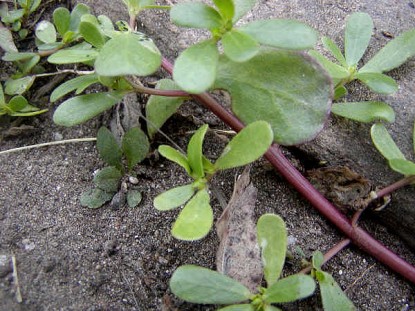
I know we could survive here, on our own, self sufficient, in a disaster or if society fails, and that is a comfort. We have emergency access to our well, and water is plentiful. We have our own source of firewood and a wood stove. There is meat here aplenty with deer, geese and ducks visiting us regularly and turkeys occasionally (even squirrel and raccoon, me being from Tennessee and all! LOL! maybe not…), medicine growing in the fields, room to grow our own food and plenty of wild food to harvest! We have a stone cold cellar and a natural freezer, just outside the door in the wintertime.
I don’t know that anything will happen here anytime soon and I don’t mean to sound like a doomsday prophet, I’m just saying…
We have been truly blessed!
Could you survive after a disaster or the fall of society?
(You know you have let go of material possessions when the thought of being self sufficient in a disaster is exciting. Is that a good thing? Hmmmmmm…don’t know…perhaps not.)
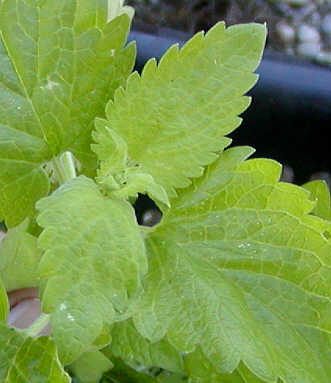
Sheryl – Runningtrails blogs at Providence Acres Farm.
Do you have a recipe post or kitchen-related story to share on the Farm Bell blog?
See Farm Bell Blog Submissions for information, the latest blog contributor giveaway, and to submit a post.
Want to subscribe to the Farm Bell blog? Go here.



Cathy J says:
For many reasons (mainly the one you mention at the post’s end) this subject is a favorite of mine. Thank you so much for writing this!
On January 2, 2012 at 7:37 am
kellyb says:
I never knew milkweed was edible. I have a huge patch growing near my mailbox. I like attracting Monarch butterflies so I always allow it to grow. I guess the butterflies will have to share this Spring.
Excellent post. I look forward to more.
On January 2, 2012 at 8:08 am
bonita says:
Euell Gibbons would be proud!
On January 2, 2012 at 10:15 am
jerseylady says:
Thanks for your good thoughts. What you say about access to water is so important. Besides our regular well, we have a dug well and a cistern on our place, just in case.
On January 2, 2012 at 11:30 am
whaledancer says:
I first got interested in foraging for wild foods as a teenager, when Euell Gibbons gave a lecture at my college. I started learning about edible wild plants simply as part of a general interest in natural science, but a few years later it helped me to survive an economic downturn. I no longer do much foraging, but I like the sense of confidence it gives me to know which plants I could live on if need be.
I am planning on a bit of foraging today, though. We have wild mustard coming up in our yard, and I thought I’d fix some for supper.
We have a number of edible weeds even in our small suburban yard: dandelion (of course), nettles, chickweed, naturalized New Zealand spinach, goosefoot, purslane, nopales, lambsquarters. Since we don’t use pesticides in our yard, I figure that in a disaster we could rustle up a pot of weed soup.
On January 2, 2012 at 11:59 am
Sheryl - Runningtrails says:
Weed soup, loL! That’s cute. That’s what we’ll be eating too!
Our yard is covered with a foot of snow now ;-(
On January 2, 2012 at 2:11 pm
murphala says:
Wow! I’m astounded to find out about milkweed. I too grow it for the butterflies, but since I was little, I was always told it was poisonous! Who knew? Thank you for posting this! So interesting!
On January 2, 2012 at 6:16 pm